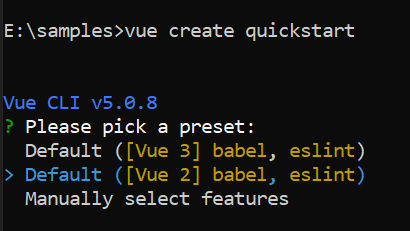Getting Started with the Vue Avatar Component in Vue 2
25 Apr 20253 minutes to read
This article provides a step-by-step guide for setting up a Vue 2 project using Vue-CLI and integrating the Syncfusion® Vue Avatar component using the Composition API / Options API.
To get start quickly with Vue Avatar component, you can check on this video:
Prerequisites
System requirements for Syncfusion® Vue UI components
Setting up the Vue 2 project
To generate a Vue 2 project using Vue-CLI, use the vue create command. Follow these steps to install Vue CLI and create a new project:
npm install -g @vue/cli
vue create quickstart
cd quickstart
npm run serveor
yarn global add @vue/cli
vue create quickstart
cd quickstart
yarn run serveWhen creating a new project, choose the option Default ([Vue 2] babel, eslint) from the menu.

Once the quickstart project is set up with default settings, proceed to add Syncfusion® components to the project.
Add Syncfusion® Vue packages
Syncfusion® packages are available at npmjs.com. To use Vue components, install the required npm package.
This article uses the Vue Avatar component as an example. Install the @syncfusion/ej2-layouts package by running the following command:
npm install @syncfusion/ej2-layouts --saveor
yarn add @syncfusion/ej2-layoutsImport Syncfusion® CSS styles
You can import themes for the Syncfusion® Vue component in various ways, such as using CSS or SASS styles from npm packages, CDN, CRG and Theme Studio. Refer to themes topic to know more about built-in themes and different ways to refer to themes in a Vue project.
In this article, the Material theme is applied using CSS styles, which are available in installed packages. The necessary Material CSS styles for the Avatar component and its dependents were imported into the <style> section of src/App.vue file.
<style>
@import "../node_modules/@syncfusion/ej2-base/styles/material.css";
@import "../node_modules/@syncfusion/ej2-layouts/styles/material.css";
</style>We can also use CRG to generate combined component styles.
Using Avatar in Vue Application
Add an HTML span element with e-avatar class into the <template> section of the App.vue file in src directory.
<template>
<div id="app">
<span class="e-avatar">GR</span>
</div>
</template>Here is the summarized code for the above steps in the src/App.vue file:
<template>
<div id='element'>
<span class="e-avatar e-avatar-xlarge"></span>
<span class="e-avatar e-avatar-large"></span>
<span class="e-avatar"></span>
<span class="e-avatar e-avatar-small"></span>
<span class="e-avatar e-avatar-xsmall"></span>
</div>
</template>
<style>
@import "../node_modules/@syncfusion/ej2-base/styles/material.css";
@import "../node_modules/@syncfusion/ej2-layouts/styles/material.css";
#element {
display: block;
width: 300px;
margin: 130px auto;
border-radius: 3px;
justify-content: center;
}
.e-avatar {
background-image: url(https://ej2.syncfusion.com/demos/src/grid/images/2.png);
margin: 2px;
}
</style>Run the project
To run the project, use the following command:
npm run serveor
yarn run serve